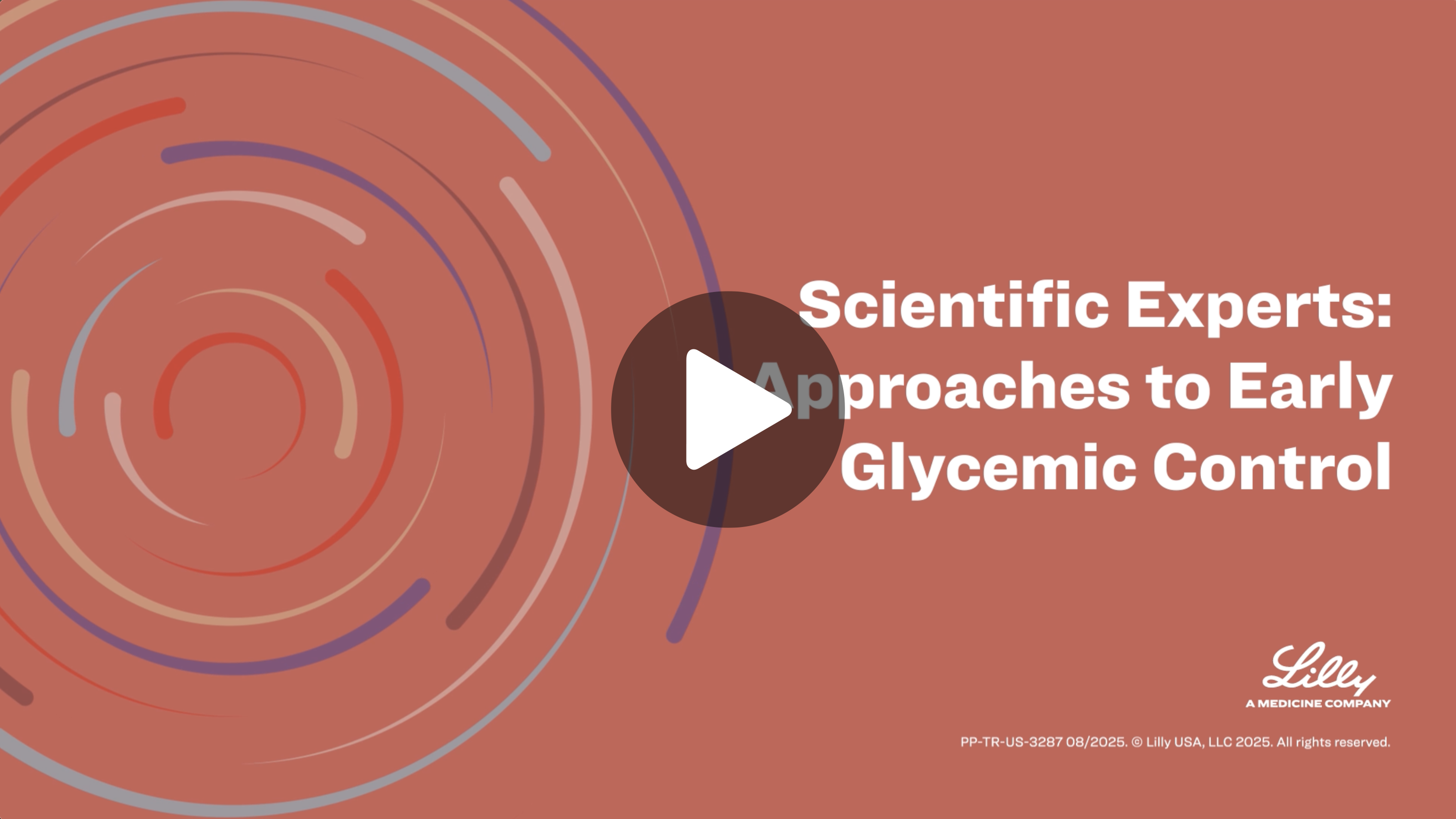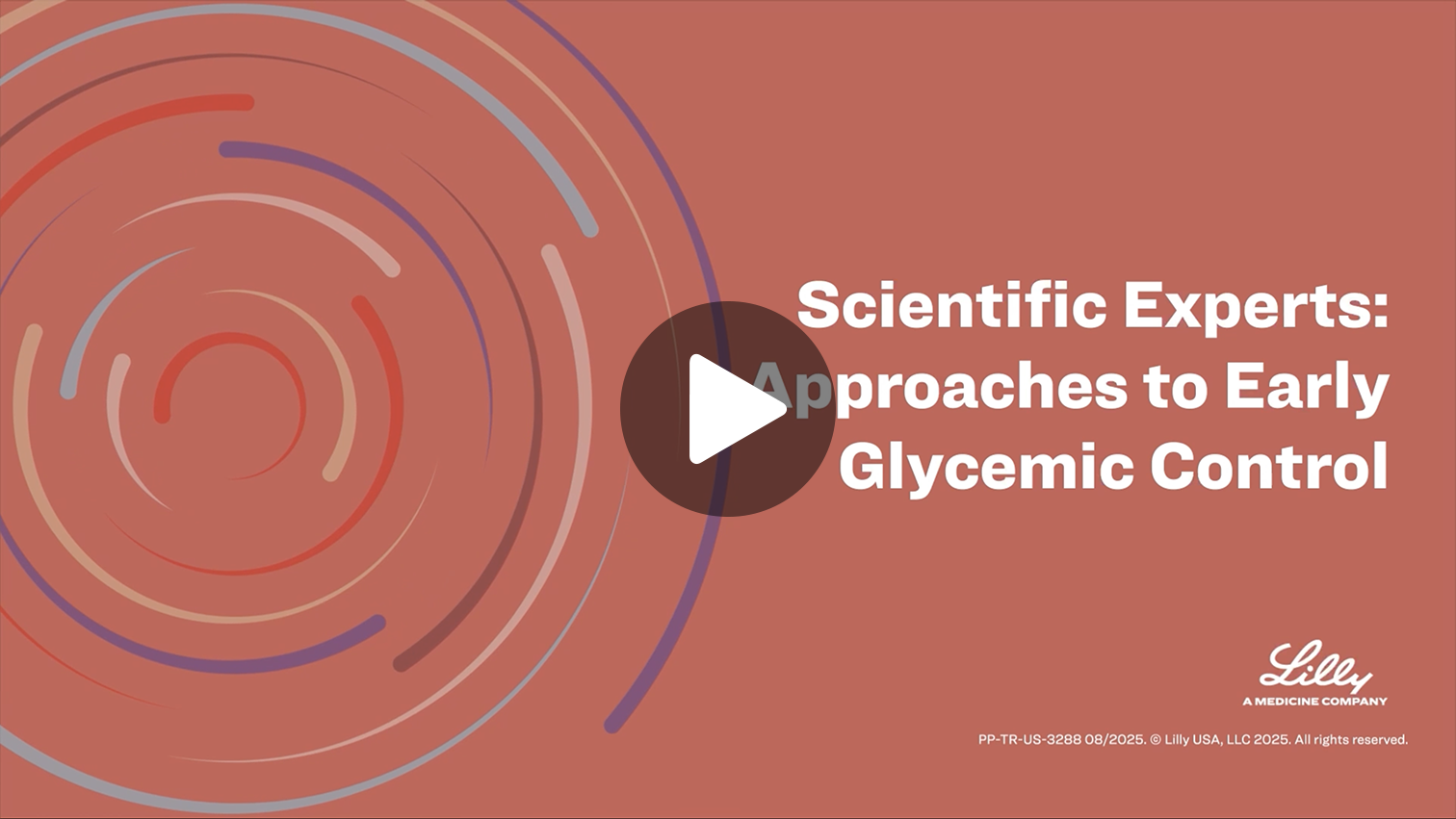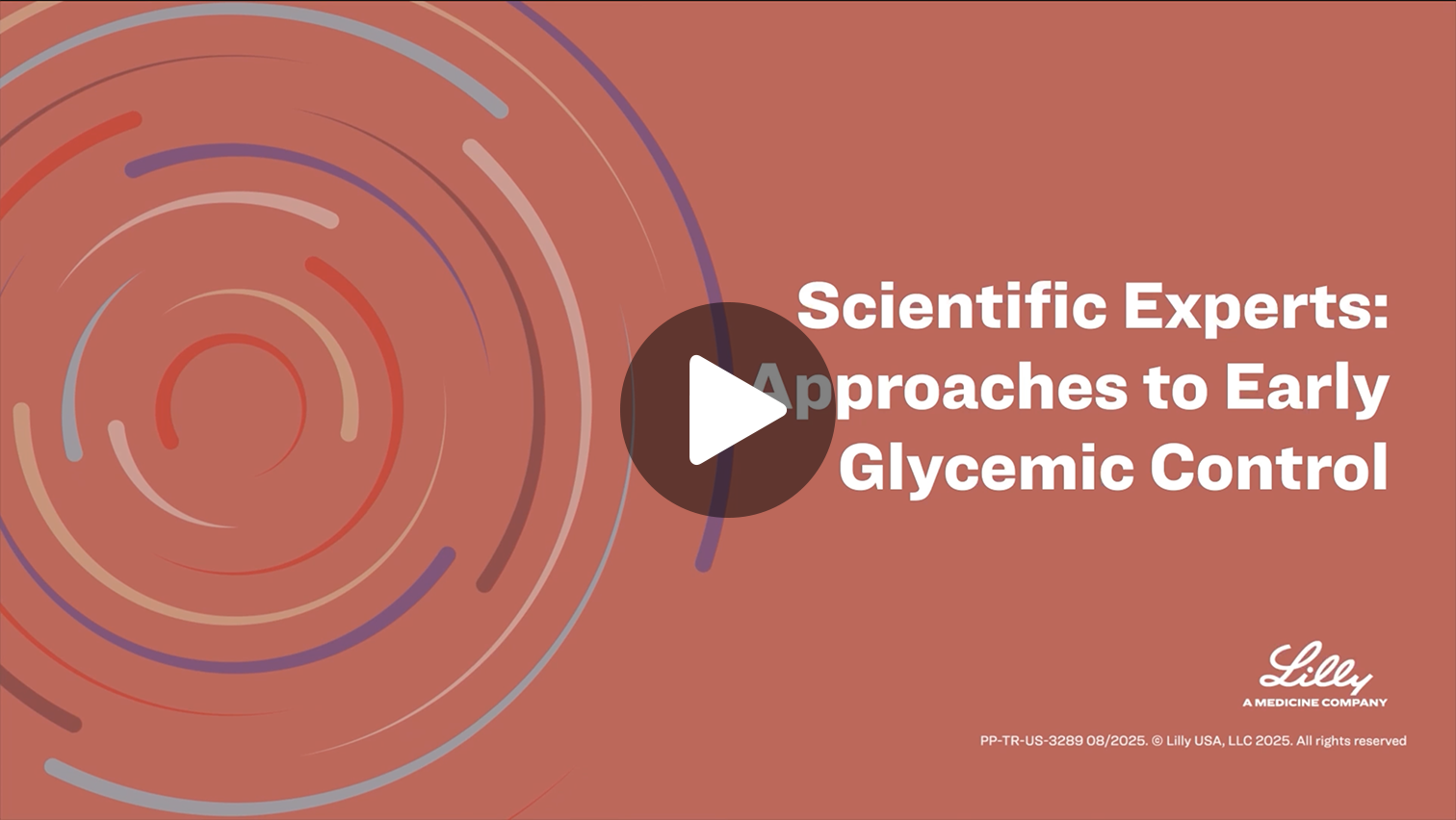A more proactive approach to T2D treatment from the initial diagnosis can support early glycemic control1
Proactive Treatment is an approach consistent with ADA/EASD recommendations to reassess patients who are not at glycemic goal every 3 months (or additionally as required for safety)1,2
Treat at the Point of Failure, or a stepwise approach where medication is changed only when symptoms become apparent rather than when glycemic targets fall outside of recommended guidelines, is often a barrier to sustained glycemic control.2
Schematic illustrations depicting hypothetical treatment scenarios1,2,3

This image—titled “Schematic illustrations depicting hypothetical treatment scenarios”—presents two schematic illustrations that compare hypothetical treatment strategies for managing diabetes. The first illustration, labeled “Treat at the Point of Failure,” features a graph with "A1c(%)" on the y-axis and "Diagnosis" on the x-axis. The graph shows a fluctuating line representing A1c levels over time, with red boxes marking sequential treatment steps, including: Diet, +Drug, +Drug, +Basal insulin, and Complex insulin regimen. The second illustration, titled “Proactive Treatment,” uses the same axis labels and treatment steps but depicts a more stable A1c trend with significant drops at intervention points. A shaded area labeled “LEGACY EFFECT” appears under part of this graph, suggesting long-term benefits of early intervention. Both graphs include the annotation “ADA/EASD goal” in blue text at the bottom right corner.
The benefits of a more proactive approach to treatment have been described in clinical trials1-4
In the 5-year VERIFY clinical trial, intensive treatment early using combination therapy that targeted multiple defects reduced time to initial and secondary treatment failures compared with a conventional stepwise approach.4*
With early combination therapy (vildagliptin/metformin), patients experienced4:
- 49% relative risk reduction in time to initial treatment failure vs metformin alone4
- 26% relative risk reduction in time to secondary treatment failure with initial combination therapy vs sequential addition of treatment4
- 5 years median time to escalate to insulin with initial combination therapy vs 3 years with a conventional stepwise approach4
*VERIFY was a 5-year, randomized, 1:1, double-blind, parallel-group study (n≈2000) designed to compare early initiation of a vildagliptin-metformin combination with standard-of-care initiation of metformin monotherapy, followed by the stepwise addition of vildagliptin when glycemia deteriorated. Participants with further deterioration were treated with insulin. Treatment failure was defined as a loss of glycemic control (2 consecutive values of HbA1c ≥7%).4,5

Proactive treatment, which can include targeting multiple defects early and combination treatment, can result in superior glycemic control and has the potential to improve long-term T2D-related outcomes.1-4
A stepwise approach has previously been the standard for treating patients with T2D.
In the 2022 ADA/EASD Consensus report, a proactive and individualized approach, including choosing high or very high efficacy treatment, should be used to support people with T2D in achieving their treatment goals.1,2

ADA Standards of Care:6
“Patients not at goal with treatment adjustments may require testing more frequently (every 3 months with interim assessments as needed for safety).”
Let’s check in on Ted!
At his initial diagnosis, Ted was prescribed metformin and lifestyle modifications. Following the guidelines, Ted's treatment was intensified at his 3-month check-in because his HbA1c was still above target at 7.2%, and he continued to have excess weight. A treatment that is effective for both glycemic control and weight management was chosen, supporting his lifestyle changes.1

Proactive Treatment
After 1 year of follow-up appointments every 3 months to assess progress or to make treatment adjustments as needed, Ted saw progress that he and his healthcare provider could feel good about and is hopeful about his future with T2D.

This image illustrates the longitudinal progression of a patient's BMI and A1c levels over a 12-month period. Initially, the patient presented with a BMI of 29 kg/m² and an A1c level of 7.8%. At the 3-month follow-up, the BMI slightly increased to 29.5 kg/m², and the A1c level decreased to 7.2%. A treatment intensification followed. At 6 months, BMI dropped to 28 kg/m², and A1c dropped to 6.5%. At 9 months, BMI measured at 26.5 kg/m² and A1c at 6.3%. At the 12-month mark, BMI measured at 26 kg/m² A1c at 6.4%.
How might Ted’s results look without early treatment intensification?
In many cases, patients like Ted do not have their medication intensified at the first sign that greater glycemic control will be needed. Observational trials have shown that many patients like Ted remain on metformin alone for over a year. Ted’s treatment journey could have looked very different if his treatment had not been intensified in that first follow-up.2,4,7
Treat at the Point of Failure
In this scenario, Ted remained on metformin at his 3-month follow-up, and his dosage was increased at his 6-month follow-up as he remained slightly above target. At his 1-year follow-up, he had not yet achieved his glycemic goals.7

This image illustrates the longitudinal progression of a patient's BMI and A1c levels over a 12-month period. At initial diagnosis, the patient presented with a BMI of 29 kg/m² and an A1c level of 7.8%. At the 3-month follow-up, the BMI slightly increased to 29.5 kg/m², and the A1c level decreased to 7.2%. By the 6-month mark, BMI rose to 29.7 kg/m² and A1c increased to 7.5%, coinciding with an escalation in the metformin dosage. A subsequent data point is missing, indicated by an "X," where neither BMI nor A1c values were recorded. At the 12-month follow-up, BMI was measured at 30.1 kg/m² and A1c at 8.1%.

ADA-EASD consensus report:1
“Weight loss of 5%-10% confers metabolic improvement; weight loss of 10%-15% or more can have a disease-modifying effect.”
Video series: Discussions with Scientific Experts
There are often challenges in practice to implementing new approaches to T2D management. Watch Dr Stefano Del Prato and Dr Jörg Simon discuss the reasons for taking a proactive approach to care and how they manage these challenges.
How do you talk about starting or adjusting T2D treatment?
4:03
00:01-00:06
[ Title screen opens with a red background and the Lilly logo. Music plays.]
CAPTION: Scientific Experts: Approaches to Early Glycemic Control
00:07-00:13
[Screen transitions to disclaimer with a white background. Music plays.]
CAPTION: Disclaimer: This video is sponsored by, and presented on behalf of, Eli Lilly and Company. It is being presented consistent with FDA guidelines and is not approved for continuing education credit.
00:14-00:47
[Screen transitions to two men—Professor Stefano Del Prato and Dr. Jörg Simon—sitting in chairs opposite one another, with a small table between them. Camera shots alternate between close-ups of the men as they speak and wide shots that include them both. The title screen is displayed in the background.]
Prof. Del Prato: Hello, I am Stefano Del Prato, professor of endocrinology and metabolism at the University of Pisa School of Medicine in Pisa, Italy.
Dr. Simon: And I’m Dr. Jörg Simon. I’m a private practice internist in Fulda, Germany, specializing in diabetology and preventative medicine for over 30 years. Today, we will answering some critical questions that our peers may have related to the importance of achieving early glycemic control in type 2 diabetes. Before we begin, here are our disclosures.
00:48-00:57
[Screen transitions to red screen displaying both men’s disclosures.]
CAPTION:
Stephano Del Prato, MD
Professor of Endocrinology and Metabolism
University of Pisa School of Medicine
Pisa, Italy
Relationships with commercial interests
Speakers bureau/honoraria:
AstraZeneca, Boehringer Ingelheim, Eli Lilly and Company, Laboratori Guidotti, Merck & Co., Novo Nordisk, Sanofi
Clinical studies:
AstraZeneca, Boehringer Ingelheim
Advisory boards:
Abbott, Amarin Corporation, Applied Therapeutics, Eli Lilly and Company, EvaPharma, Hengrui Therapeutics Inc, Menarini International, Novo Nordisk, Sandoz, Sun Pharma
Jörg Simon, MD
Diabetologist and Preventative Medicine Internist
Fulda, Germany
Relationships with commercial interests
Speakers bureau/honoraria:
Allmirall, Allergika, Amgen, Astellas, AstraZeneca/Bristol Myers Squibb, Baxter, Bayer, Berlin-Chemie, Boehringer Ingelheim, Dr. Kade/Besins Pharma, Eli Lilly and Company, GSK, Infectopharm, KWHC, Medical Tribune, MSD, Novartis, Novo Nordisk, OmniaMed, Praxis-Depesche, Recordati Pharma, Roche Diagnostics, Sanofi, Taurus Pharma
Clinical studies:
Amgen, AstraZeneca/Bristol Myers Squibb, Bayer Vital, Boehringer Ingelheim, Covance, Eli Lilly and Company, HANMI, ICON, ICVIA, Janssen-Cilag, MSD, Novartis, Novo Nordisk, Parexel, Pfizer, Pharmalog, Roche, Sanofi
Advisory boards:
Amgen, Bayer, Boehringer Ingelheim, Bristol Myers Squibb, Dexcom, Eli Lilly and Company, Janssen-Cilag, LifeScan, MSD, Novo Nordisk, Pfizer, Roche Diagnostics, Sanofi
00:58-01:03
[Screen transitions to still screen displaying the text of a question that is read by Prof. Del Prato.]
Prof. Del Prato: How do you discuss adding or escalating treatment with people with type 2 diabetes?
01:03-02:31
[Screen transitions to video of Dr. Simon answering Prof. Del Prato’s question. While Dr. Simon is talking, screen transitions from a close-up of Dr. Del Prato to a wide shot of both men in conversation, and then back again. The text of the question asked by Prof. Del Prato remains in the background.]
Dr. Simon: When discussing treatment changes with people with type 2 diabetes, I show them discrepancy between some of their key measurements—such as weight and hemoglobin A1C—and their goals. I explain the guidelines that provide treatment recommendations and share with them how the efficacy of newer medication classes for glycemic control and weight management could benefit them.
I have conversations with them to revisit their goals. Shared decision-making is very important. I may prescribe a different medication or combination of medications based on what their individual needs are.
Sometimes people with type 2 diabetes do not want to add more medications to their treatment regimen, and so for those people, a combination pill or weekly injection can be very helpful.
Additionally, when I prescribe a new medication, I ask the person to give me feedback on it, usually in a few weeks, by giving my office a phone call. I also always talk about lifestyle changes. In Germany, most people with type 2 diabetes receive a great deal of education from national diabetes education programs. We find that people who are well informed are more positive and motivated, and it is very important to continue to provide lifestyle counseling at all stages of therapy.
02:31-03:02
[Camera shot is on Prof. Del Prato as he speaks. Camera then pans out to include both men during Prof. Del Prato’s response.]
Prof. Del Prato: Thank you for sharing. And I completely agree—it is important to have this dialogue with the person with type 2 diabetes. The latest version of the ADA/EASD Consensus Report has a strong emphasis on shared decision-making as well as recommendations around the type of language to be used during clinical interactions.
People with diabetes need to be educated not only on the complexity of the disease, but also on the multiple therapeutic options that are available to help them reach their treatment goals.
03:02-03:51
[Screen transitions to wide shot of both men in conversation as Prof. Del Prato continues speaking. The text of the question asked by Prof. Del Prato remains in the background.]
Prof. Del Prato: When I talk to my patients, I explain to them why we need the therapies that target the disease in multiple ways. I discuss the potential benefits of the treatment and also inform them about potential side effects. I offer advice about how to minimize side effects and resolve them. I tell them to reach out to my office if they have any questions. When I do this, I have very few people who have concerns about the management plan.
What is also needed is positive reinforcement and motivation for people with type 2 diabetes, because it is a lifelong condition. You can prescribe the best medication in the world, but if the person with type 2 diabetes does not take it, it will not work. They need to be on board, and in order for that to happen, sharing the decision is key.
03:51-03:53
[Screen transitions to close shot of Dr. Simon as he responds.]
Dr. Simon: Yes, agreed.
03:54-04:03
[Screen transitions to red background with the Lilly logo.]
PP-TR-US-3284 08/2025 ©Lilly USA, LLC 2025. All rights reserved.

How do you talk about starting or adjusting T2D treatment?
4:03

What evidence supports earlier T2D treatment?
5:42

What are the benefits of adding medication before T2D treatment failure?
5:51

Why choose highly effective medications early in T2D treatment?
5:05

How can clinicians apply T2D guidelines in daily practice?
2:41
References
- Davies MJ, Aroda VR, Collins BS, et al. Management of hyperglycemia in type 2 diabetes, 2022. A consensus report by the American Diabetes Association (ADA) and the European Association for the Study of Diabetes (EASD). Diabetes Care. 2022;45(11):2753-2786. doi:10.2337/dci22-0034
- Campbell IW. Need for intensive, early glycemic control in patients with type 2 diabetes. J Brit Cardiol. 2000;7:625-631.
- Holman RR, Paul SK, Bethel MA, et al. 10-year follow-up of intensive glucose control in type 2 diabetes. N Engl J Med. 2008;359(15):1577-1589. doi:10.1056/NEJMoa0806470
- Matthews D, Del Prato S, Mohan V, et al. Insights from VERIFY: early combination therapy provides better glycaemic durability than a stepwise approach in newly diagnosed type 2 diabetes. Diabetes Ther. 2020;11(11):2465-2476. doi:10.1007/s13300-020-00926-7
- Del Prato S, Foley JE, Kothny W, et al. Study to determine the durability of glycaemic control with early treatment with a vildagliptin-metformin combination regimen vs. standard-of-care metformin monotherapy—the VERIFY trial: a randomized double-blind trial. Diabet Med. 2014;31(10):1178-1184. doi:10.1111/dme.12508
- American Diabetes Association Professional Practice Committee. 6. Glycemic targets: Standards of Medical Care in Diabetes—2022. Diabetes Care. 2022;45(suppl 1):S83-S96.
- Gomes MB, Rathmann W, Charbonnel B, et al. Treatment of type 2 diabetes mellitus worldwide: baseline patient characteristics in the global DISCOVER study. Diabetes Res Clin Pract. 2019;151:20-32. doi:10.1016/j.diabres.2019.03.024